View the new videos on the Lab on a Chip YouTube site below:
.
Bipolar electrochemistry for cargo-lifting in fluid channels
.
.
Mesh-integrated microdroplet array for simultaneous merging and storage of single-cell droplets
.
View the new videos on the Lab on a Chip YouTube site below:
.
Bipolar electrochemistry for cargo-lifting in fluid channels
.
.
Mesh-integrated microdroplet array for simultaneous merging and storage of single-cell droplets
.
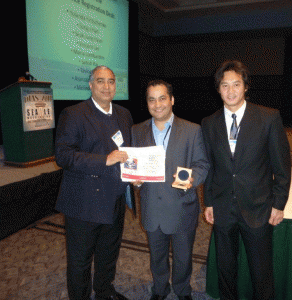
Editor Harp Minhas and Editorial Board member Po Ki Yuen (Corning Inc) with Ali Khademhosseini (2011 Lectureship winner)
The Lab on a Chip/Corning Inc Pioneers of Miniaturisation Lecture is awarded annually to an early to mid-career scientist for extraordinary or outstanding contributions to the understanding or development of miniaturised systems.
The Lectureship is jointly awarded by Lab on a Chip and Corning Incorporated at the annual µTAS Conference, to be held this year in Okinawa, Japan, and includes $5000 ($2000 of which may be used to attend µTAS).
Previous winners include Professor Stephen Quake (Stanford, California, USA) and Professor Ali Khademhosseini (Harvard-MIT, USA).
We would like to invite you to nominate your outstanding colleagues for this lectureship – the deadline for nominations is 28th May 2012. Full details of the criteria and how to submit the nominations are to be found on the Pioneers of Miniaturisation Lecture webpage.
 Lab on a Chip will again be publishing a themed issue dedicated to the work of Emerging Investigators, guested edited by Professors Amy Herr and Aaron Wheeler, with the aim of giving wide-spread exposure to current advances from new investigators and stimulate further progress in the field based on these new advances.
Lab on a Chip will again be publishing a themed issue dedicated to the work of Emerging Investigators, guested edited by Professors Amy Herr and Aaron Wheeler, with the aim of giving wide-spread exposure to current advances from new investigators and stimulate further progress in the field based on these new advances.
We are inviting promising researchers, to contribute original research in their own areas of expertise to make a valuable addition to the current literature via this exciting project. The Emerging Investigators themed issue will focus on technical contributions made by investigators who started their first independent position (e.g., Assistant Professor) within the last seven years.
We are hoping that you will be able to make a contribution of original, unpublished work conducted in your independent laboratory for this issue.
For an example of a previous Emerging Investigators issue, please see here.
The final submission deadline for manuscripts will be April 30, 2012, with the aim of publication to coincide with µTAS 2012, in late-October 2012. If you would like more information, or wish to contribute to this exciting issue, please contact the Lab on a Chip Editorial Office.
Read on for a quick round up of four HOT articles published recently in Lab on a Chip:
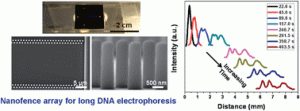 Sung-Gyu Park and colleagues from the University of Minnesota present a nanofence array for DNA electrophoresis that requires no direct-write nanopatterning.
Sung-Gyu Park and colleagues from the University of Minnesota present a nanofence array for DNA electrophoresis that requires no direct-write nanopatterning.
DNA electrophoresis in a nanofence array
Sung-Gyu Park, Daniel W. Olson and Kevin D. Dorfman
DOI: 10.1039/C2LC00016D
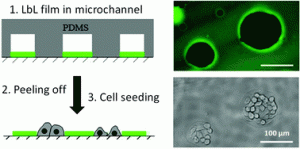 Narayanan Madaboosi et al. demonstrate the micropatterning of soft films using a microfluidic device for selective cell growth.
Narayanan Madaboosi et al. demonstrate the micropatterning of soft films using a microfluidic device for selective cell growth.
Microfluidics meets soft layer-by-layer films: selective cell growth in 3D polymer architectures
Narayanan Madaboosi, Katja Uhlig, Stephan Schmidt, Magnus S. Jäger, Helmuth Möhwald, Claus Duschl and Dmitry V. Volodkin
DOI: 10.1039/C2LC40058H
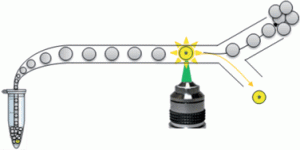 Mira T. Guo et al. at Harvard University present a critical review focusing on droplet microfluidics, and the advantages offered for biological assays.
Mira T. Guo et al. at Harvard University present a critical review focusing on droplet microfluidics, and the advantages offered for biological assays.
Droplet microfluidics for high-throughput biological assays
Mira T. Guo, Assaf Rotem, John A. Heyman and David A. Weitz
DOI: 10.1039/C2LC21147E
Eugene J. Lim and colleagues demonstrate the use of particle trajectory analysis to observe the inertial focusing behaviour of a range of particles and cells (including prostate cancer cells) in blood.
Visualization of microscale particle focusing in diluted and whole blood using particle trajectory analysis
Eugene J. Lim, Thomas J. Ober, Jon F. Edd, Gareth H. McKinley and Mehmet Toner
DOI: 10.1039/C2LC21100A
These HOT articles are free to access for the next four weeks (following a simple registration for individual users), so why not take a look?
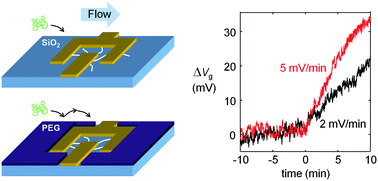
Congratulations to the authors!
Read the articles on Science Daily, PhysOrg.com and nanowerk.com or go straight to the Lab on a Chip paper:
Increasing the detection speed of an all-electronic real-time biosensor
Matthew R. Leyden , Robert J. Messinger , Canan Schuman , Tal Sharf , Vincent T. Remcho , Todd M. Squires and Ethan D. Minot
DOI: 10.1039/C2LC21020G
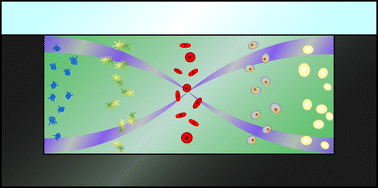
If you’ve missed any of the previous articles take a look at the web collection here.
View the new videos on the Lab on a Chip YouTube site below:
Concentration landscape generators for shear free dynamic chemical stimulation
.
Microfluidic platform for combinatorial synthesis in picolitre droplets
.
Pulsed laser triggered high speed microfluidic fluorescence activated cell sorter
.
.
Experimental validation of plugging during drop formation in a T-junction
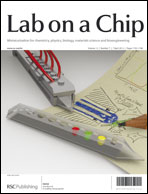
A multifunctional pipette
Alar Ainla, Gavin D. M. Jeffries, Ralf Brune, Owe Orwar and Aldo Jesorka
DOI: 10.1039/C2LC20906C

Engineers are from PDMS-land, Biologists are from Polystyrenia
Erwin Berthier, Edmond W. K. Young and David Beebe
DOI: 10.1039/C2LC20982A
Another HOT article in this issue is by Serge G. Lemay and colleagues at the MESA+ Institute for Nanotechnology, University of Twente, reporting on their study of the response time of nanofluidic thin-layer cells as electrochemical sensors, and suggested means of improving that time.
Response time of nanofluidic electrochemical sensors
Shuo Kang, Klaus Mathwig and Serge G. Lemay
DOI: 10.1039/C2LC21104A
This issue also features the latest article in our Acoustofluidics series, by Thomas Laurell and colleagues at Lund University, Applications of acoustophoresis in continuous flow microsystems; and our latest Research Highlights from Ali Khademhosseini and colleagues.
As usual, all our HOT articles are free to access for four weeks (following a simple registration for individual users).
US scientists have developed a device dubbed Gene-Z for point-of-care genetic testing using a smartphone interface that has realistic commercial potential.
The device, made by Robert Stedtfeld at Michigan State University and colleagues, is cheap, with an estimated manufacture cost of less than $350. It’s small, about the size of a tablet computer, and weighs less than a bag of sugar. And, you can operate it via an app on a smartphone.
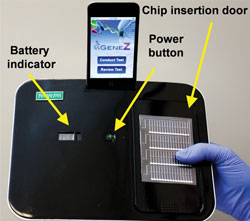
The Gene-Z device
The team’s prototype consists of a disposable plastic chip with four arrays containing the dried primers required for a genetic assay, allowing parallel processing of four samples with multiple genetic markers for accurate disease diagnosis. The chip sits in an aluminium heater bed, through which LEDs are fed for real-time optical detection, and the whole thing is encased in sleek black packaging with a dock for an iPod Touch or iPhone.
Holger Becker, co-founder of microfluidic ChipShop, Germany, is impressed. ‘I like it for a couple of reasons,’ he says, ‘it’s not over-engineered, it addresses a couple of very typical problems in a point-of-care diagnostic device and there is a simplicity in the approach, especially in the detection system.’
The team made two major changes to existing designs, explains team member Syed Hashsham. First, they made the disposable microfluidic chip from polyester, rather than the more traditional silicon or polydimethylsiloxane. Hashsham says he was inspired by ‘kitchen chemistry’. If plastic food bags can be sealed to keep your sandwiches fresh, he reasoned, then plastic membranes in the chip would stop samples escaping during loading. This avoids the need for mechanical valves and the plastic chips are easy to design and fabricate. You can think one up in the morning and use it in the afternoon, he says, whereas silicon chips take weeks to develop.
Second, the team rejected polymerase chain reactions (PCR) in favour of the loop-mediated isothermal amplification (LAMP) assay. The LAMP assay requires no thermal cycling, requires cheaper optics for detection and is robust – as opposed to PCR, which Hashsham describes as ‘finicky’. Finally, they used WiFi and a smartphone with a custom-built app as the interface to manage data from the device.
Using WiFi does throw up a couple of problems, however: the safe transmission of potentially sensitive patient data via a wireless network, use in hospital settings where signals can interfere with other equipment and viability in areas without an internet connection. Stedtfeld and his team are working with other groups to address the encryption and interference issues. They say that their next step is to make the Gene-Z device compatible with an ordinary mobile phone, so that information can be transmitted via SMS and, by adding solar cells, the device could be used in rural settings.
Gene-Z: a device for point of care genetic testing using a smartphone
Robert D. Stedtfeld, Dieter M. Tourlousse, Gregoire Seyrig, Tiffany M. Stedtfeld, Maggie Kronlein, Scott Price, Farhan Ahmad, Erdogan Gulari, James M. Tiedje and Syed A. Hashsham
DOI: 10.1039/C2LC21226A
Read the original article at Chemistry World
This month sees the following articles in Lab on a Chip that are in the top ten most accessed:
Antigen-responsive, microfluidic valves for single use diagnostics
Brad J. Berron, Allison M. May, Zheng Zheng, Vivek Balasubramaniam and Christopher N. Bowman
Lab Chip, 2012, 12, 708-710
DOI: 10.1039/C2LC21101G
High throughput production of single core double emulsions in a parallelized microfluidic device
Mark B. Romanowsky, Adam R. Abate, Assaf Rotem, Christian Holtze and David A. Weitz
Lab Chip, 2012, 12, 802-807
DOI: 10.1039/C2LC21033A
Young researchers to tackle future Grand Challenges
Anna Sjöström Douagi and Helene Andersson Svahn
Lab Chip, 2012, 12, 680-683
DOI: 10.1039/C1LC90138A
Education: a microfluidic platform for university-level analytical chemistry laboratories
Jesse Greener, Ethan Tumarkin, Michael Debono, Andrew P. Dicks and Eugenia Kumacheva
Lab Chip, 2012, 12, 696-701
DOI: 10.1039/C2LC20951A
Rapid prototyping of three-dimensional microfluidic mixers in glass by femtosecond laser direct writing
Yang Liao, Jiangxin Song, En Li, Yong Luo , Yinglong Shen, Danping Chen, Ya Cheng, Zhizhan Xu, Koji Sugioka and Katsumi Midorikawa
Lab Chip, 2012, 12, 746-749
DOI: 10.1039/C2LC21015K
Continuous separation of microparticles in a microfluidic channel via the elasto-inertial effect of non-Newtonian fluid
Jeonghun Nam, Hyunjung Lim, Dookon Kim, Hyunwook Jung and Sehyun Shin
Lab Chip, 2012, Advance Article
DOI: 10.1039/C2LC21304D
Sorting cells by size, shape and deformability
Jason P. Beech, Stefan H. Holm, Karl Adolfsson and Jonas O. Tegenfeldt
Lab Chip, 2012, 12, 1048-1051
DOI: 10.1039/C2LC21083E
Polyurethane-based microfluidic devices for blood contacting applications
Wen-I Wu, Kyla N. Sask, John L. Brash and P. Ravi Selvaganapathy
Lab Chip, 2012, 12, 960-970
DOI: 10.1039/C2LC21075D
Design of pressure-driven microfluidic networks using electric circuit analogy
Kwang W. Oh, Kangsun Lee, Byungwook Ahn and Edward P. Furlani
Lab Chip, 2012, 12, 515-545
DOI: 10.1039/C2LC20799K
Surfactants in droplet-based microfluidics
Jean-Christophe Baret
Lab Chip, 2012, 12, 422-433
DOI: 10.1039/C1LC20582J
Why not take a look at the articles today and blog your thoughts and comments below.
Fancy submitting an article to Lab on a Chip? Then why not submit to us today or alternatively email us your suggestions.